陕旅版四年级上册英语教案
- 格式:doc
- 大小:87.00 KB
- 文档页数:11
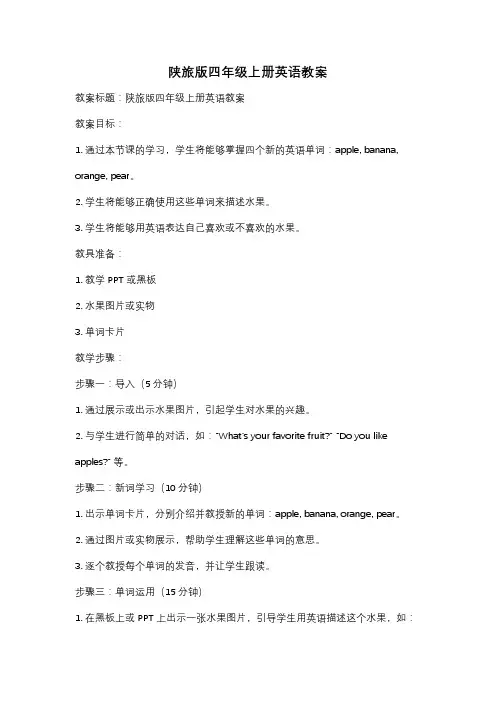
陕旅版四年级上册英语教案教案标题:陕旅版四年级上册英语教案教案目标:1. 通过本节课的学习,学生将能够掌握四个新的英语单词:apple, banana, orange, pear。
2. 学生将能够正确使用这些单词来描述水果。
3. 学生将能够用英语表达自己喜欢或不喜欢的水果。
教具准备:1. 教学PPT或黑板2. 水果图片或实物3. 单词卡片教学步骤:步骤一:导入(5分钟)1. 通过展示或出示水果图片,引起学生对水果的兴趣。
2. 与学生进行简单的对话,如:“What's your favorite fruit?” “Do you like apples?” 等。
步骤二:新词学习(10分钟)1. 出示单词卡片,分别介绍并教授新的单词:apple, banana, orange, pear。
2. 通过图片或实物展示,帮助学生理解这些单词的意思。
3. 逐个教授每个单词的发音,并让学生跟读。
步骤三:单词运用(15分钟)1. 在黑板上或PPT上出示一张水果图片,引导学生用英语描述这个水果,如:“This is an apple. It's red and round.”。
2. 让学生分组,每组选择一张水果图片,并用英语描述该水果。
3. 鼓励学生使用新学的单词,并给予肯定和鼓励。
步骤四:情感教育(10分钟)1. 引导学生表达自己对不同水果的喜好或不喜好,如:“I like apples. They are sweet.” 或者“I don't like bananas. They are too soft.”。
2. 鼓励学生用英语描述自己的喜好,并与同学进行交流。
步骤五:总结(5分钟)1. 复习本节课学习的新单词和句型。
2. 鼓励学生用英语描述他们最喜欢的水果,并与同学分享。
教学延伸:1. 让学生自己制作水果贴纸,并用英语标注水果的名称。
2. 鼓励学生在家中或学校的食堂观察和描述不同水果的特点。
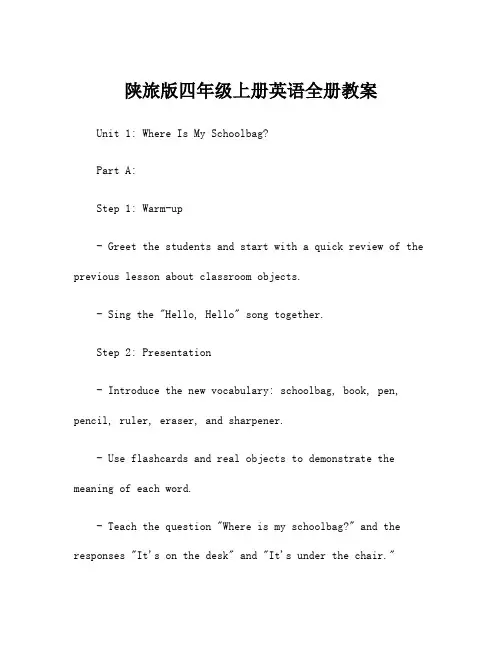
陕旅版四年级上册英语全册教案Unit 1: Where Is My Schoolbag?Part A:Step 1: Warm-up- Greet the students and start with a quick review of the previous lesson about classroom objects.- Sing the "Hello, Hello" song together.Step 2: Presentation- Introduce the new vocabulary: schoolbag, book, pen, pencil, ruler, eraser, and sharpener.- Use flashcards and real objects to demonstrate the meaning of each word.- Teach the question "Where is my schoolbag?" and the responses "It's on the desk" and "It's under the chair."Step 3: Practice- Role-play the dialogue with a few students, using the new vocabulary and question.- Have students work in pairs to practice the dialogue, switching roles to take turns.Step 4: Consolidation- Play a "Find the Object" game where students have to listen to a description and find the corresponding object in the classroom.Step 5: Wrap-up- Review the new vocabulary and sentence structures before moving on to the next activity.Part B:Step 1: Listening- Play the audio recording of the dialogue and have students follow along in their books.Step 2: Speaking- Have students practice the dialogue in pairs, using the audio recording as a reference.Step 3: Reading- Ask students to read the dialogue aloud, focusing on pronunciation and intonation.Step 4: Writing- In their workbooks, have students write the dialogue using the correct punctuation and capitalization.Step 5: Group Activity- Divide the class into groups and have them create a similar dialogue using the new vocabulary. Each group will then perform their dialogue for the class.Step 6: Review- Review the key vocabulary and grammar points covered in this lesson.Step 7: Homework- Assign the students to write a short paragraph describing the items in their schoolbag.。
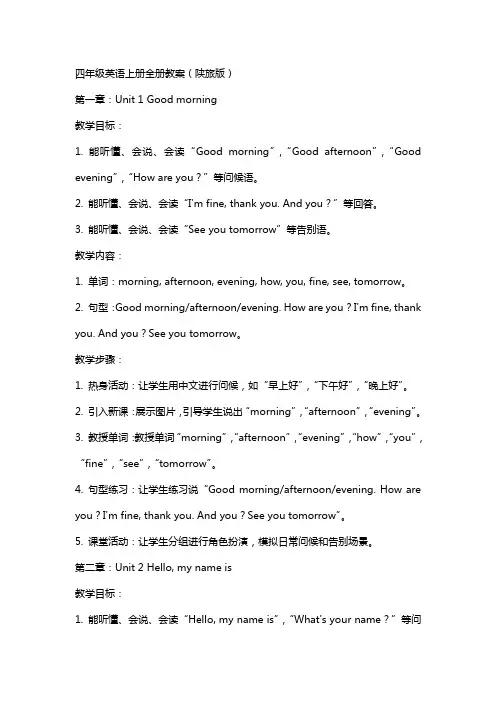
四年级英语上册全册教案(陕旅版)第一章:Unit 1 Good morning教学目标:1. 能听懂、会说、会读“Good morning”,“Good afternoon”,“Good evening”,“How are you?”等问候语。
2. 能听懂、会说、会读“I'm fine, thank you. And you?”等回答。
3. 能听懂、会说、会读“See you tomorrow”等告别语。
教学内容:1. 单词:morning, afternoon, evening, how, you, fine, see, tomorrow。
2. 句型:Good morning/afternoon/evening. How are you?I'm fine, thank you. And you?See you tomorrow。
教学步骤:1. 热身活动:让学生用中文进行问候,如“早上好”,“下午好”,“晚上好”。
2. 引入新课:展示图片,引导学生说出“morning”,“afternoon”,“evening”。
3. 教授单词:教授单词“morning”,“afternoon”,“evening”,“how”,“you”,“fine”,“see”,“tomorrow”。
4. 句型练习:让学生练习说“Good morning/afternoon/evening. How are you?I'm fine, thank you. And you?See you tomorrow”。
5. 课堂活动:让学生分组进行角色扮演,模拟日常问候和告别场景。
第二章:Unit 2 Hello, my name is教学目标:1. 能听懂、会说、会读“Hello, my name is”,“What's your name?”等问候和自我介绍用语。
2. 能听懂、会说、会读“I'm Tom.”等自我介绍。
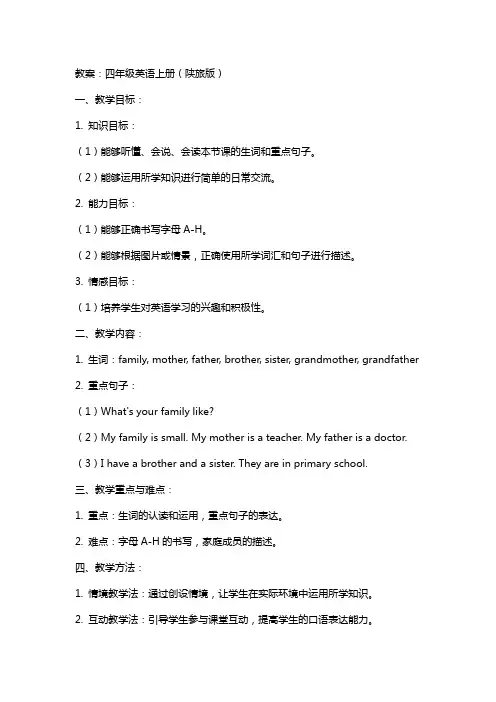
教案:四年级英语上册(陕旅版)一、教学目标:1. 知识目标:(1)能够听懂、会说、会读本节课的生词和重点句子。
(2)能够运用所学知识进行简单的日常交流。
2. 能力目标:(1)能够正确书写字母A-H。
(2)能够根据图片或情景,正确使用所学词汇和句子进行描述。
3. 情感目标:(1)培养学生对英语学习的兴趣和积极性。
二、教学内容:1. 生词:family, mother, father, brother, sister, grandmother, grandfather2. 重点句子:(1)What's your family like?(2)My family is small. My mother is a teacher. My father is a doctor. (3)I have a brother and a sister. They are in primary school.三、教学重点与难点:1. 重点:生词的认读和运用,重点句子的表达。
2. 难点:字母A-H的书写,家庭成员的描述。
四、教学方法:1. 情境教学法:通过创设情境,让学生在实际环境中运用所学知识。
2. 互动教学法:引导学生参与课堂互动,提高学生的口语表达能力。
3. 游戏教学法:通过趣味游戏,激发学生的学习兴趣。
五、教学步骤:1. 热身(5分钟)(1)和学生打招呼,询问他们昨天做了什么。
(2)引导学生用英语回答,复习已学的日常用语。
2. 引入(10分钟)(1)展示图片,引导学生描述家庭成员。
(2)引导学生用英语介绍自己的家庭成员。
3. 生词学习(10分钟)(1)教授生词:family, mother, father, brother, sister, grandmother, grandfather。
(2)让学生跟读,巩固记忆。
4. 句子学习(10分钟)(1)教授重点句子:What's your family like? My family is small. My mother is a teacher. My father is a doctor. I have a brother and a sister. They are in primary school.(2)让学生跟读,并进行角色扮演。

陕旅版四年级上册英语全册教案完整版一、教学内容1. Chapter 1: My School详细内容:学习描述学校场所和设施的词汇,如library, classroom, playground等,以及相关句型,如What's this? It's a2. Chapter 2: My Family详细内容:学习家庭成员的词汇,如mother, father, sister 等,以及介绍家庭成员的句型,如This is my3. Chapter 3: My Body详细内容:学习身体部位的词汇,如head, eyes, ears等,以及描述身体不适的句型,如My head hurts.二、教学目标1. 让学生掌握本册书中的词汇和句型,能运用所学知识进行简单的英语对话。
2. 培养学生的英语听力、口语表达能力,提高他们的英语学习兴趣。
3. 培养学生的团队合作意识,提高他们的课堂参与度。
三、教学难点与重点1. 教学难点:词汇的掌握和句型的运用。
2. 教学重点:培养学生的英语听说能力,提高他们的语言实际运用能力。
四、教具与学具准备1. 教具:PPT、卡片、录音机、磁带等。
2. 学具:英语课本、练习本、彩色笔等。
五、教学过程1. 导入:通过展示与课题相关的图片,引导学生用英语进行讨论,激发学生的学习兴趣。
2. 新课内容展示:讲解新词汇和句型,配合PPT和实物展示,让学生直观地理解和学习。
3. 例题讲解:针对新课内容,设计典型例题,引导学生分析和解答。
4. 随堂练习:设计相关练习题,让学生巩固所学知识,提高实际运用能力。
5. 小组活动:分组进行角色扮演,用所学知识进行英语对话,培养学生的团队合作意识。
六、板书设计1. 板书内容:包括新课词汇、句型、典型例题等。
2. 板书布局:左侧列出词汇,右侧列出句型,中间展示例题和解答。
七、作业设计1. 作业题目:(1)抄写新课词汇,每个词汇写5遍。
(2)根据所学句型,编写一段关于自己学校的英语对话。
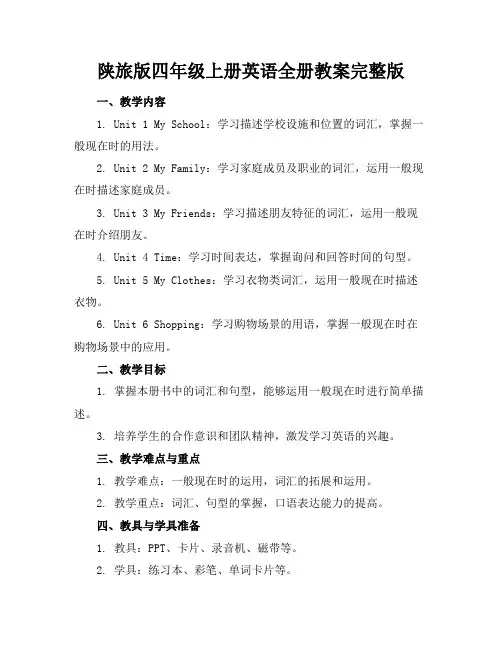
陕旅版四年级上册英语全册教案完整版一、教学内容1. Unit 1 My School:学习描述学校设施和位置的词汇,掌握一般现在时的用法。
2. Unit 2 My Family:学习家庭成员及职业的词汇,运用一般现在时描述家庭成员。
3. Unit 3 My Friends:学习描述朋友特征的词汇,运用一般现在时介绍朋友。
4. Unit 4 Time:学习时间表达,掌握询问和回答时间的句型。
5. Unit 5 My Clothes:学习衣物类词汇,运用一般现在时描述衣物。
6. Unit 6 Shopping:学习购物场景的用语,掌握一般现在时在购物场景中的应用。
二、教学目标1. 掌握本册书中的词汇和句型,能够运用一般现在时进行简单描述。
3. 培养学生的合作意识和团队精神,激发学习英语的兴趣。
三、教学难点与重点1. 教学难点:一般现在时的运用,词汇的拓展和运用。
2. 教学重点:词汇、句型的掌握,口语表达能力的提高。
四、教具与学具准备1. 教具:PPT、卡片、录音机、磁带等。
2. 学具:练习本、彩笔、单词卡片等。
五、教学过程1. 导入:通过创设情境,引导学生复习旧知识,为新课学习做好铺垫。
2. 新课呈现:展示PPT,讲解新词汇和句型,让学生跟读和模仿。
3. 例题讲解:通过实例讲解,让学生了解一般现在时的用法,并进行实际操作。
4. 随堂练习:设计各种练习题,巩固所学知识,提高学生的运用能力。
5. 小组活动:分组进行角色扮演,练习口语表达能力,培养合作精神。
六、板书设计1. 陕旅版四年级上册英语教案2. 内容:各单元主题、重点词汇、句型、一般现在时的用法等。
七、作业设计1. 作业题目:a. 抄写并默写本节课所学词汇。
b. 根据所给情景,用一般现在时完成句子。
c. 编写一段关于自己学校、家庭或朋友的介绍,运用所学词汇和句型。
2. 答案:见附件。
八、课后反思及拓展延伸2. 拓展延伸:a. 布置拓展阅读任务,提高学生的阅读能力。
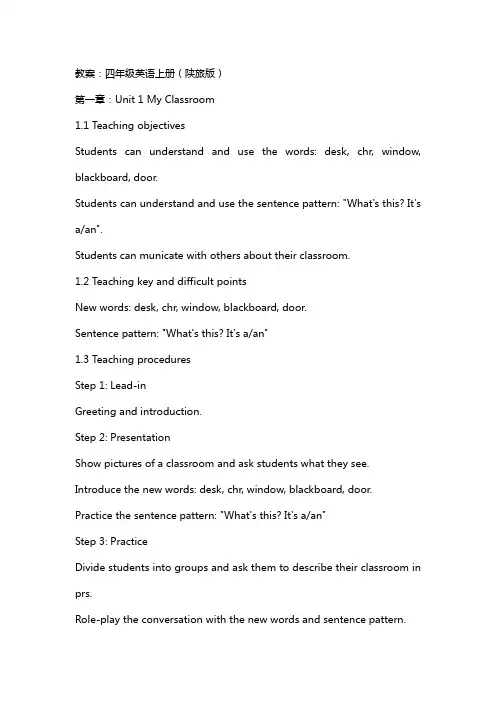
教案:四年级英语上册(陕旅版)第一章:Unit 1 My Classroom1.1 Teaching objectivesStudents can understand and use the words: desk, chr, window, blackboard, door.Students can understand and use the sentence pattern: "What's this? It's a/an".Students can municate with others about their classroom.1.2 Teaching key and difficult pointsNew words: desk, chr, window, blackboard, door.Sentence pattern: "What's this? It's a/an"1.3 Teaching proceduresStep 1: Lead-inGreeting and introduction.Step 2: PresentationShow pictures of a classroom and ask students what they see. Introduce the new words: desk, chr, window, blackboard, door. Practice the sentence pattern: "What's this? It's a/an"Step 3: PracticeDivide students into groups and ask them to describe their classroom in prs.Role-play the conversation with the new words and sentence pattern.Step 4: ConsolidationAsk students to draw their classroom and label the objects with the new words.Present and pare the drawings with the class.1.4 HomeworkPractice the sentence pattern: "What's this? It's a/an" with parents. Write a short description of their classroom.第二章:Unit 2 My Body2.1 Teaching objectivesStudents can understand and use the words: head, eyes, nose, mouth, ears, arm, leg.Students can understand and use the sentence pattern: "Point to your". Students can municate with others about their body.2.2 Teaching key and difficult pointsNew words: head, eyes, nose, mouth, ears, arm, leg.Sentence pattern: "Point to your"2.3 Teaching proceduresStep 1: Lead-inGreeting and introduction.Step 2: PresentationShow pictures of different body parts and ask students what they are. Introduce the new words: head, eyes, nose, mouth, ears, arm, leg.Practice the sentence pattern: "Point to your"Step 3: PracticeAsk students to point to their body parts and say the words.Role-play the conversation with the new words and sentence pattern. Step 4: ConsolidationAsk students to work in groups and create a poem about their body parts.Present and share the poems with the class.2.4 HomeworkPractice the sentence pattern: "Point to your" with parents.Draw a picture of their body and label the body parts.第三章:Unit 3 My Family3.1 Teaching objectivesStudents can understand and use the words: father, mother, brother, sister, grandmother, grandfather.Students can understand and use the sentence pattern: "This is my". Students can municate with others about their family.3.2 Teaching key and difficult pointsNew words: father, mother, brother, sister, grandmother, grandfather. Sentence pattern: "This is my"3.3 Teaching proceduresStep 1: Lead-inGreeting and introduction.Step 2: PresentationShow pictures of different family members and ask students who they are.Introduce the new words: father, mother, brother, sister, grandmother, grandfather.Practice the sentence pattern: "This is my"Step 3: PracticeAsk students to introduce their family members using the new words and sentence pattern.Role-play the conversation with the new words and sentence pattern. Step 4: ConsolidationAsk students to work in groups and create a short story about their family.Present and share the stories with the class.3.4 HomeworkPractice the sentence pattern: "This is my" with parents.Draw a picture of their family and label the family members.第四章:Unit 4 My Home4.1 Teaching objectivesStudents can understand and use the words: house, door, window, floor, roof, bed, chr.Students can understand and use the sentence pattern: "What's in your home?".Students can municate with others about their home.4.2 Teaching key and difficult pointsNew words: house, door, window, floor, roof, bed, chr.Sent第六章:Unit 5 My School6.1 Teaching objectivesStudents can understand and use the words: school, classroom, teacher, desk, chr, blackboard.Students can understand and use the sentence pattern: "I go to school ". Students can municate with others about their school life.6.2 Teaching key and difficult pointsNew words: school, classroom, teacher, desk, chr, blackboard. Sentence pattern: "I go to school "6.3 Teaching proceduresStep 1: Lead-inGreeting and introduction.Step 2: PresentationShow pictures of a school and ask students what they see.Introduce the new words: school, classroom, teacher, desk, chr, blackboard.Practice the sentence pattern: "I go to school "Step 3: PracticeAsk students to talk about their way to school.Role-play the conversation with the new words and sentence pattern. Step 4: ConsolidationAsk students to write a short story about their school day.Share the stories with the class.6.4 HomeworkPractice the sentence pattern: "I go to school " with parents.Draw a picture of their school and label the objects.第七章:Unit 6 My Clothes7.1 Teaching objectivesStudents can understand and use the words: clothes, shirt, pants, skirt, shoes, hat.Students can understand and use the sentence pattern: "What's this? It's a/an".Students can municate with others about their clothes.7.2 Teaching key and difficult pointsNew words: clothes, shirt, pants, skirt, shoes, hat.Sentence pattern: "What's this? It's a/an"7.3 Teaching proceduresStep 1: Lead-inGreeting and introduction.Step 2: PresentationShow pictures of different clothes and ask students what they are. Introduce the new words: clothes, shirt, pants, skirt, shoes, hat. Practice the sentence pattern: "What's this? It's a/an"Step 3: PracticeAsk students to point to their clothes and say the words.Role-play the conversation with the new words and sentence pattern. Step 4: ConsolidationAsk students to work in groups and create a poem about clothes. Present and share the poems with the class.7.4 HomeworkPractice the sentence pattern: "What's this? It's a/an" with parents. Draw a picture of their clothes and label the items.第八章:Unit 7 Food8.1 Teaching objectivesStudents can understand and use the words: food, rice, noodles, meat, vegetable, fruit.Students can understand and use the sentence pattern: "I like". Students can municate with others about their favorite food.8.2 Teaching key and difficult pointsNew words: food, rice, noodles, meat, vegetable, fruit.Sentence pattern: "I like"8.3 Teaching proceduresStep 1: Lead-inGreeting and introduction.Step 2: PresentationShow pictures of different food items and ask students what they are. Introduce the new words: food, rice, noodles, meat, vegetable, fruit. Practice the sentence pattern: "I like"Step 3: PracticeAsk students to talk about their favorite food.Role-play the conversation with the new words and sentence pattern. Step 4: ConsolidationAsk students to work in groups and create a list of healthy foods. Present and share the lists with the class.8.4 HomeworkPractice the sentence pattern: "I like" with parents.Write a short paragraph about their favorite food.第九章:Unit 8 Colors9.1 Teaching objectivesStudents can understand and use the words: colors, red, yellow, blue, green, black, white.Students can understand and use the sentence pattern: "What color is it?It's".Students can municate with others about colors.9第十章:Unit 9 Animals10.1 Teaching objectivesStudents can understand and use the words: animals, cat, dog, fish, bird, mouse.Students can understand and use the sentence pattern: "What's this? It's a/an".Students can municate with others about animals.10.2 Teaching key and difficult pointsNew words: animals, cat, dog, fish, bird, mouse.Sentence pattern: "What's this? It's a/an"10.3 Teaching proceduresStep 1: Lead-inGreeting and introduction.Step 2: PresentationShow pictures of different animals and ask students what they are. Introduce the new words: animals, cat, dog, fish, bird, mouse. Practice the sentence pattern: "What's this? It's a/an"Step 3: PracticeAsk students to point to the animals and say the words.Role-play the conversation with the new words and sentence pattern. Step 4: ConsolidationAsk students to work in groups and create a poem about animals. Present and share the poems with the class.10.4 HomeworkPractice the sentence pattern: "What's this? It's a/an" with parents. Draw a picture of their favorite animal and label it.第十一章:Unit 10 Seasons11.1 Teaching objectivesStudents can understand and use the words: seasons, spring, summer, autumn, winter.Students can understand and use the sentence pattern: "What's the weather like? It's".Students can municate with others about the weather and seasons. 11.2 Teaching key and difficult pointsNew words: seasons, spring, summer, autumn, winter.Sentence pattern: "What's the weather like? It's"11.3 Teaching proceduresStep 1: Lead-inGreeting and introduction.Step 2: PresentationShow pictures of different seasons and ask students what they are.Introduce the new words: seasons, spring, summer, autumn, winter. Practice the sentence pattern: "What's the weather like? It's"Step 3: PracticeAsk students to talk about the weather in different seasons.Role-play the conversation with the new words and sentence pattern. Step 4: ConsolidationAsk students to work in groups and create a chart about the weather in different seasons.Present and share the charts with the class.11.4 HomeworkPractice the sentence pattern: "What's the weather like? It's" with parents.Write a short paragraph about their favorite season and why.第十二章:Unit 11 Numbers12.1 Teaching objectivesStudents can understand and use the words: numbers, one, two, three, four, five.Students can understand and use the sentence pattern: "How many? There are".Students can count and municate with others about numbers.12.2 Teaching key and difficult pointsNew words: numbers, one, two, three, four, five.Sentence pattern: "How many? There are"12.3 Teaching proceduresStep 1: Lead-inGreeting and introduction.Step 2: PresentationShow pictures of different objects and ask students how many there are. Introduce the new words: numbers, one, two, three, four, five. Practice the sentence pattern: "How many? There are"Step 3: PracticeAsk students to count objects in the classroom.Role-play the conversation with the new words and sentence pattern. Step 4: ConsolidationAsk students to work in groups and create a poster about numbers. Present and share the posters with the class.12.4 HomeworkPractice the sentence pattern: "How many? There are" with parents. Count objects at home and write a short story about what they counted. 第十三章:Unit 12 Family and Friends13.1 Teaching objectivesStudents can understand and use the words: family, friends, mother, father, sister, brother.Students can understand and use the sentence pattern: "This is my".Students can municate with others about their family and friends.13.2 Teaching key and difficult points重点和难点解析。

Unit 1 What is your father?单元知识目标:一、复习单词:Grangpa,grandma,father,mother,brother,sister,teacher,student.二、能听、说、读、写有关职业的单词:Cook,doctor,driver,policeman,nurse,worker,famer.三、能听懂、会说、会读、会用与家庭成员和职业有关的交际用语:1.¬-What is your...?-He/She is a...-What about...?-He/She is a...your mother a...?-No,shen` is a...is he/she?-She/He is a...want to be a...情感目标:1、通过复习谈论家庭成员,培养学生热爱家庭的情感。
2、在学习和讨论职业话题中帮助学生树立正确的职业观。
第一课时教学目标:1、复习有关家庭成员的词:grandpa,grangma,father,mother,brother,sister.2、学习有关职业的单词:cook,doctor,driver,policeman,nurse,worker,famer.教学重点:能听懂、会说“What is your father/mother?He/She is a...”日常用语。
教学难点:能在日常生活中灵活运用这些句型。
教学准备:1、教师准备:(1)一张自己的全家福,一张Anne(或其他名字)的全家福和表现cook,doctor,driver,policeman,nurse,worker,famer职业的人物图片。
(2)录音机、磁带。
(3)农场、医院等图片或课件。
教学过程:一、课程导入1、课前问答教师出示自己的全家福,向学生逐一介绍自己的家人。
2、新课导入教师拿着书作讲课状、作开车状、作在田间劳动状,向学生边演示边说:I am a can .I am a can drive.滴滴滴,滴滴滴。
![[陕旅版四年级上册英语全册教案(含单元知识点总结)]](https://uimg.taocdn.com/b19712f4a8114431b80dd88f.webp)
[陕旅版四年级上册英语全册教案(含单元知识点总结)][陕旅版四年级上册英语全册教案(含单元知识点总结)] What is your father? 一、知识也能力目标。
1、掌握本节课中出现的新单词。
2、掌握本节课中的句型What is your father/mother?及其回答。
二、过程与方法1、用PPT、歌曲引入,营造氛围,让学生对所学单词进行初步感知,在教师的引导下能自主学习、合作学习,提高学习能力。
2、能够掌握运用所学句型,自主对话。
三、情感态度与价值观通过对单词学习,让学生了解各项职业。
通过学习让学生感知各项职业都非常辛苦,让他们能体会父母工作的艰辛,并爱自己的父母。
教学目标:1、掌握本课的职业单词,并能正确、流利的拼读,理解词义。
2、掌握本课的句型What is your father/mother?询问他人职业的用语及其正确回答。
3、能正确流利读小诗。
教学重点:1. 1.能听懂、会说、会拼写,认读职业单词,并对单词teacher 进行复习巩固。
2. 2.能听懂What’s your …?并能根据实际情况用He’s/she’sa …回答。
3. 3.能听懂、会说What’s he/she ? 并能根据实际情况用He’s/she’s a …回答。
4. 4.能读小诗歌What is your father\mother? 教学难点1.能听懂What’s your …?并能根据实际情况用He’s/she’s a …回答。
2.能听懂、会说What’s he/she ? 并能根据实际情况用He’s/she’s a …回答。
3.能配动作诵读小诗歌What is your father\mother ? 教学准备:PPT 教学过程:Step1:T:1、greeting 2、sing a song T:Today is sunny。
Are you happy?S:Yes。
T:Now,let′s sing a song。
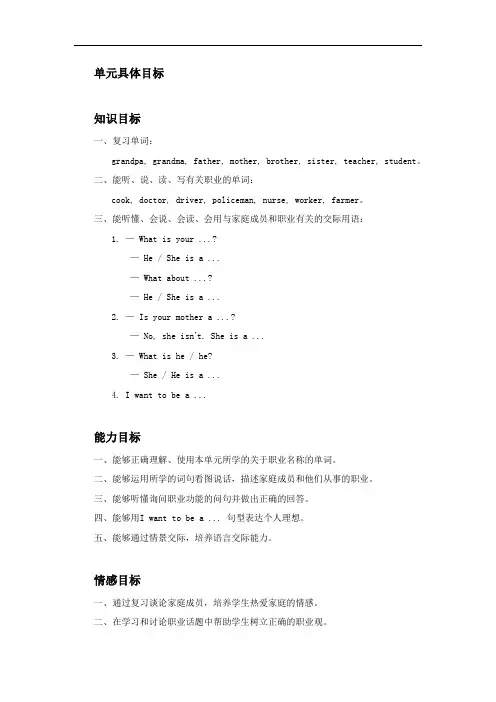
单元具体目标知识目标一、复习单词:grandpa, grandma, father, mother, brother, sister, teacher, student。
二、能听、说、读、写有关职业的单词:cook, doctor, driver, policeman, nurse, worker, farmer。
三、能听懂、会说、会读、会用与家庭成员和职业有关的交际用语:1. — What is your ...?— He / She is a ...— What about ...?— He / She is a ...2. — Is your mother a ...?— No, she isn’t. She is a ...3. — What is he / he?— She / He is a ...4. I want to be a ...能力目标一、能够正确理解、使用本单元所学的关于职业名称的单词。
二、能够运用所学的词句看图说话,描述家庭成员和他们从事的职业。
三、能够听懂询问职业功能的问句并做出正确的回答。
四、能够用I want to be a ... 句型表达个人理想。
五、能够通过情景交际,培养语言交际能力。
情感目标一、通过复习谈论家庭成员,培养学生热爱家庭的情感。
二、在学习和讨论职业话题中帮助学生树立正确的职业观。
第一课时教学目标1. 复习有关家庭成员的单词:grandpa, grandma, father, mother, brother,sister。
2. 学习有关职业的单词:cook, doctor, driver, policeman, nurse, worker,farmer。
3. 能根据教师指令灵活运用上述单词。
4. 引导学生感知字母组合oo, er 在单词中的读音。
教学准备Ⅰ.课程导入(Leading In)ⅰ. 课前提问1. 教师出示自己的全家福,向学生逐一介绍自己的家人。
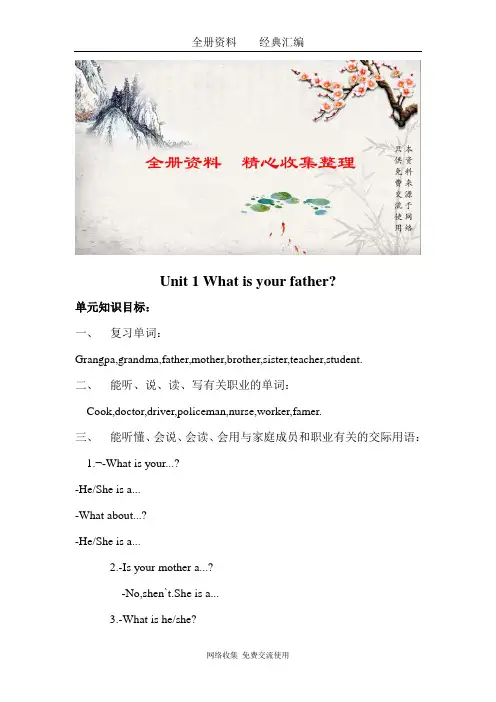
Unit 1 What is your father?单元知识目标:一、复习单词:Grangpa,grandma,father,mother,brother,sister,teacher,student.二、能听、说、读、写有关职业的单词:Cook,doctor,driver,policeman,nurse,worker,famer.三、能听懂、会说、会读、会用与家庭成员和职业有关的交际用语:1.¬-What is your...?-He/She is a...-What about...?-He/She is a...2.-Is your mother a...?-No,shen`t.She is a...3.-What is he/she?-She/He is a...4.I want to be a...情感目标:1、通过复习谈论家庭成员,培养学生热爱家庭的情感。
2、在学习和讨论职业话题中帮助学生树立正确的职业观。
第一课时教学目标:1、复习有关家庭成员的词:grandpa,grangma,father,mother,brother,sister.2、学习有关职业的单词:cook,doctor,driver,policeman,nurse,worker,famer.教学重点:能听懂、会说“What is your father/mother?He/She is a...”日常用语。
教学难点:能在日常生活中灵活运用这些句型。
教学准备:1、教师准备:(1)一张自己的全家福,一张Anne(或其他名字)的全家福和表现cook,doctor,driver,policeman,nurse,worker,famer职业的人物图片。
(2)录音机、磁带。
(3)农场、医院等图片或课件。
教学过程:一、课程导入1、课前问答教师出示自己的全家福,向学生逐一介绍自己的家人。
2、新课导入教师拿着书作讲课状、作开车状、作在田间劳动状,向学生边演示边说:I am a teacher.I can teach.ABCDEFG.I am a driver.I can drive.滴滴滴,滴滴滴。
陕旅版四年级上册英语全册教案完整版一、教学内容本节课为陕旅版四年级上册英语第8单元第二课时。
主要学习内容为动物类词汇:cat, dog, panda, tiger, bear, penguin,以及一般疑问句及其回答。
二、教学目标1. 学生能够听懂、会说、会读本节课的生词,并能够运用到实际情景中。
2. 学生能够理解并运用一般疑问句及其回答进行交流。
3. 学生能够通过本节课的学习,提高自己的观察能力和合作意识。
三、教学难点与重点重点:动物类词汇的掌握和运用。
难点:一般疑问句及其回答的运用。
四、教具与学具准备教具:PPT、卡片、动物头饰。
学具:课本、铅笔、练习本。
五、教学过程1. 热身(5分钟)教师播放英语歌曲,引导学生跟唱,活跃课堂气氛。
2. 引入(10分钟)教师通过展示动物图片,引导学生说出动物名称,从而引入本节课的主题。
3. 呈现(10分钟)教师利用PPT展示本节课的生词,同时引导学生跟读,确保学生能够正确发音。
4. 操练(10分钟)教师组织学生进行小组活动,用所学词汇进行对话,巩固记忆。
5. 应用(10分钟)教师创设情景,引导学生运用一般疑问句及其回答进行交流。
7. 作业布置(5分钟)学生回家后,用所学词汇和句型编写一个小故事,明天分享给大家。
六、板书设计动物词汇:cat, dog, panda, tiger, bear, penguin一般疑问句:Is it a cat/dog/panda/tiger/bear/penguin?回答:Yes, it is. / No, it isn't.七、作业设计1. 抄写本节课的生词,每个词写5遍。
八、课后反思及拓展延伸本节课通过生动有趣的图片和情景,引导学生学习了动物词汇和一般疑问句。
在教学中,要注意观察学生的反应,确保每个学生都能参与到课堂活动中。
课后,可以组织学生进行动物主题的绘画活动,让学生在绘画中进一步巩固所学知识。
重点和难点解析一、教学内容细节1. 动物类词汇教学:本节课主要学习陕旅版四年级上册英语第8单元第二课时的动物类词汇,包括cat, dog, panda, tiger, bear,penguin。
陕旅版四年级英语上册教案教案标题:陕旅版四年级英语上册教案教学目标:1. 通过本单元的学习,学生能够掌握以下词汇:apple, banana, bread, cake, egg, fish, grape, hamburger, ice cream, juice, key, lemon, milk, noodle, orange, pear, queen, rabbit, strawberry, tomato, umbrella, vegetable, watermelon, xylophone, yogurt, zebra。
2. 学生能够正确使用句型"What's this? It's a/an..."和"What's your favorite food? My favorite food is..."进行简单的日常交流。
3. 培养学生的听、说、读、写的能力,提高他们的英语综合运用能力。
教学重点:1. 学习并掌握本单元的词汇。
2. 学会正确使用"What's this? It's a/an..."和"What's your favorite food? My favorite food is..."进行简单的交流。
教学难点:1. 学生能够正确运用"What's this? It's a/an..."和"What's your favorite food? My favorite food is..."进行口语交流。
2. 学生能够正确拼读和书写本单元的词汇。
教学准备:1. 课件、图片或实物展示食物和其他相关词汇。
2. 学生练习本单元词汇的练习册。
教学过程:Step 1: Warm-up (热身活动)1. Greeting (问候学生)T: Good morning/afternoon, class!S: Good morning/afternoon, teacher!2. Sing a song (唱一首英语歌曲)选择一首与食物相关的英语歌曲,让学生跟着节奏和歌词一起唱。
陕旅版小学四年级英语上全册教案期中测试题一、写出下列字母的相邻字母。
(10分)__ Dd __ __Ii __ __Pp __ __Tt __ __Ww ____Ff __ __Kk __ __Qq __ __Mm __ __Uu __二、填入所缺的字母,是单词完整正确。
(10分)( ) 1.p ___ ple A.eo B.oe C.ou( ) 2.b ___ ch A.ea B.ae C.ee( ) 3. gr___dma A.ea B.an C.oa( ) 4. ci____ma A.en B.ne C.nu( ) 5. fam ____ly A.a B.i C.ir( ) 6. engin ___ r A.ee B.er C.ea( ) 7.h ____sewife A.or B.uo C.ou( ) 8.fri ____dly A.ne B.en C.ee( ) 9.g ____l A.ur B.ir C.ri( ) 10.k ____d A.ie B.ni C.in(10分)()1. A. uncle B. who C. aunt D. cousin ()2. A. dad B. mum C.love D. grandpa ()3. A. barber B. doctor C. photo D. nurse ()4. A.my B.his C.her D.taxi()5. A.panda B.hippo C.monkey D. doll( )1.a taxi driver A.互相( )2.a happy family B.一位家庭主妇( )3.a little dog C.一个幸福的家庭( )4.a housewife D.一位出租车司机( )5.each other E.一只小狗( )6.an engineer F.好朋友( )7.on the beach G.在树上( )8.good friend H.一位工程师( )9.in the tree I.在电影院里( )10.in the cinema J.在沙滩上( ) 1.He is ___engineerA.an B .a C. the( )2.I___ a bag.A.atB. inC. have( ) 3.This ___my father.A.isB. amC. are( ) e ___ see my uncle’s family!A.forB. toC. on( ) 5.How many people are there ___ your family? A.at B.in C.for( ) 6.There ___three people in Tom’s family.A.haveB. are C .be( ) 7.How old ___ she?A.isB. areC. am( ) 8.Look ___ the picture of my family.A.onB. at C .in( ) 9.I am ___ pupil.A.theB. anC. a( ) 10. A photo ___ my room.A. ofB. forC. in1. your/the/is/father/man/(?)___________________________________________ 2. there/your/family/in/are/many/people/how/(?)___________________________________________3. they/who/are/(?)___________________________________________4. is/how/she/old/(?)___________________________________________5. they/kind/are/(.)___________________________________________( ) 1.She is sister .A.她是我妹妹。
陕旅版小学英语四年级上册全册教案陕西旅游版四年级英语上册教案学校:教师:日期:陕旅版小学四年级《英语》上册教材分析1. 陕旅版小学四年级《英语》上册教育理念教材是实施课标的手段之一,是对课标的具体细化,在实际教学中是主要的教学资料,科学地对教材定位就是用教材教,而不是教教材。
修订后的陕旅版小学四年级《英语》上册教材依据国家教育部公布的2022版英语课程标准,严格遵循新课标的教育理念和教学目标,以“话题—功能—结构—任务〞为根本思路编写设计而成的。
该书以Alice、Su Nan、Kitty、Wu Chen、Colin、Kevin、Li Shan、Liu Zhaoyang 以及活泼可爱、滑稽有趣的Toby和Aggie为主线形象;由他们带着同学们,在真实自然的情景中,通过参与各种内容丰富、形式多样的语言活动,来感知和体验语言,并逐渐学会运用语言进行简单交流,从而到达新课标提出的小学英语教学的各工程标。
同时,该书以学生为本,注重小学四年级学生的年龄特点和心理特征,从调动和激发其对英语的学习兴趣入手,通过大量贴近生活实际、富有时代气息的形式灵活多样的主题和内容和朗朗上口、富有韵律感的英语歌曲和歌谣以及生动有趣的卡通图片画面,让学生在听、说、唱、演、玩中主动汲取新知,为以后的英语学习奠定扎实的根底。
2. 陕旅版小学四年级《英语》上册内容特色a. 生动性:教材版式设计图文相间,比例适度,疏密有致;插图新颖活泼,符合儿童审美情趣,努力营造轻松、活泼的教材面貌,从直觉和感知层面激发学生学习兴趣。
如局部单元中Part B的Read astory局部,教材中的图画与磁带中的故事紧密结合,构成立体的视听结构,以更形象化的语言和场景相结合让学生稳固所学知识内容,以培养学生学英语的兴趣、信心、策略和习惯为根本出发点,为学生英语能力的持续开展打下坚实的根底。
b. 趣味性:教材中安排了节奏明快的chant、具有较强感染力的英文歌曲、走迷宫、涂颜色等教学内容,听、说、做、玩、唱、演的内容安排,使表现形式丰富多样,既富于情趣,又能开发学生智力。
陕西旅游版四年级上册英语教案陕西旅游版四年级英语上册教案教学设计Unit1 What Is Your Father?第一课时教学目标:学习“四会”单词:cook, doctor, driver, policeman, nurse, worker, farmer 并用所学单词和句型描述职业。
教学重点:能听懂、会写、会读、会说cook, doctor, driver, policeman, nurse, worker, farmer教学难点:通过学习,能够用英语描述职业。
教学环节:一.学习目标(2分钟)(一)出示学习目标:学习“四会”单词:cook, doctor, driver, policeman, nurse, worker, farmer 并用所学单词和句型描述职业。
(二)学生齐读学习目标,明确本节课任务。
二.自主学习(15分钟)(一)温故知新1.出示全家福,向学生逐一介绍自己的家庭成员。
2.做Look and write.(二)引入新课对照课本,边看边练习拼写描述职业的单词。
(三)互助释疑1学生集体听磁带跟读单词,要求指读。
2个别学生展示,教师及时评价。
3 教师逐一对学生容易出错的单词进行有针对性的训练。
(四)探究出招同桌间练习书写,可以互相检查拼写。
三.展示交流(10分钟)(一)小组展示小组内练习用英语描述职业(二)班级展示1 指名小组上讲台做游戏,用英语描述职业,你来表演我来猜。
2 补全单词。
教师出示单词,让学生口述出所缺字母。
driv work doct farm四.点拨升华(8分钟)(一)教师放录音,学生跟读,纠正读音。
(二)学生开火车读单词。
五.课堂作业(5分钟)作业当堂清1.单词拼写driv work doct farm2.翻译厨师医生警察农民工人护士3.完成Look and write.板书设计:cook doctor policeman nurse worker farmer课后反思:第一课时学案预习案1.能认识,能写会cook, doctor, driver, policeman, nurse, worker, farmer2.能用单词描述家庭成员职业。
陕西旅游版四年级上册英语教案陕西旅游版四年级英语上册教案教学设计Unit1 What Is Your Father?第一课时教学目标:学习“四会”单词:cook, doctor, driver, policeman, nurse, worker, farmer 并用所学单词和句型描述职业。
教学重点:能听懂、会写、会读、会说cook, doctor, driver, policeman, nurse, worker, farmer教学难点:通过学习,能够用英语描述职业。
教学环节:一.学习目标(2分钟)(一)出示学习目标:学习“四会”单词:cook, doctor, driver, policeman, nurse, worker, farmer 并用所学单词和句型描述职业。
(二)学生齐读学习目标,明确本节课任务。
二.自主学习(15分钟)(一)温故知新1.出示全家福,向学生逐一介绍自己的家庭成员。
2.做Look and write.(二)引入新课对照课本,边看边练习拼写描述职业的单词。
(三)互助释疑1学生集体听磁带跟读单词,要求指读。
2个别学生展示,教师及时评价。
3 教师逐一对学生容易出错的单词进行有针对性的训练。
(四)探究出招同桌间练习书写,可以互相检查拼写。
三.展示交流(10分钟)(一)小组展示小组内练习用英语描述职业(二)班级展示1 指名小组上讲台做游戏,用英语描述职业,你来表演我来猜。
2 补全单词。
教师出示单词,让学生口述出所缺字母。
driv work doct farm四.点拨升华(8分钟)(一)教师放录音,学生跟读,纠正读音。
(二)学生开火车读单词。
五.课堂作业(5分钟)作业当堂清1.单词拼写driv work doct farm2.翻译厨师医生警察农民工人护士3.完成Look and write.板书设计:cook doctor policeman nurse worker farmer课后反思:第一课时学案预习案1.能认识,能写会cook, doctor, driver, policeman, nurse, worker, farmer2.能用单词描述家庭成员职业。
UNIT 4 When do you have classes?单元总目标本单元的教学分为4个课时。
第一个课时以词汇教学为主,词汇教学自然要在情景中进行,以帮助学生理解词汇。
第二课时在复习词汇的基础上,重点学习日常生活中的某时做某事。
第三课时以Part B中的Let`s learn more为主,拓展学习第三人称单数的特殊疑问句及回答When does she/he...?She/He gets up at...第四课时在有效拓展练习本单元的重点内容的基础上,完成检测并通过故事学习达到一定的情感教育目标。
第4单元的教学可分为4个课时。
具体课时分配情况见下表:具体目标在本单元的教学中,教师要充分结合学生的日常活动,并且借助教学挂图、卡片和多媒体,让学生充分地了解掌握日常生活的英语表达,并能达到以下知识目标和情感目标:知识目标一、能听、说、读、写以下词汇:Get up、have a class、have lunch、play games、watch TV、go to bed二、能听懂、会说、会读、会用下到句型:1.一When do you+动词短语?—I...2.一Do you+动词短语?—Yes,we do.3.—When does your father/mother+动词短语?—He/She...情感目标一、引导学生养成合理安排时间、规律生活的好习惯。
二、鼓励学生和他人进行小组合作,培养学生的合作能力。
第一课时教学目标:1.能听懂、会说、会写词汇:get up,have class,have lunch,play games,watch TV,go to bed.2.灵活运用上述词汇。
教学重点:能听懂、会说、会写词汇:get up,have class,have lunch,play games,watch TV,go to bed.教学难点:灵活运用上述词汇。
教学方法:高效课堂模式。
学习方法:教学准备:1.教师准备:(1)Let`s learn部分的教学卡片、磁带及录音机。
(2)卡通时钟。
(时针分针可以用手控制)(3)歌曲视频。
2.学生准备水彩笔。
培优辅差:教学过程:一、课程导入(Leading In)1.课前问答教师与学生做课前问候,进行日常的口语练习。
教师的问题中可以涉及之前学过的几个单元的重点内容。
可通过简短的会话,复习巩固前面学过的一些内容。
具体问题参考如下:(1)Hello,boys and girls.How are you?(2)What`s for breakfast?(3)Do you like eggs for breakfast?(4)Do you like English?2.新课导入教师给学生播放歌曲视频:This is the way.让学生边看边唱,以此激起学生学习新课的兴趣。
由于这首歌是英文歌曲中的经典作品,如果不能播放视频,教师可以带着学生一起边做动作边唱歌。
二、课程展示活动和过程1.Let`s learn通过课本第26页Let`s learn部分的主图或课件展示进行词汇的新授。
因为本节课中所学习的词汇都与学生的日常生活有关,所有教师可以直接通过演示让学生了解和掌握。
(1)T:Look at the clock.It`s seven in the morning.T:I want to get up.I get up at seven.教师做起床的动作,让学生跟着一起做动作并重复单词get up.T:I get up at six.Do you get up at six?S1:Yes,I do./No,I don`t.T:Do you get up at seven?S1:Yes,I do./No,I don`t.(2)教师借助卡通时钟拨动时间,按照时间顺序来学习接下来的活动。
教师可在展示时间的同时向学生展示活动照片或图片,让学生一边做动作一边说出相应的动词短语。
2.教师在四线三格中写出本节课的词汇,让学生随着教师的书写进行拼读,让学生眼到、手到、口到、心到。
之后,播放Let`s learn部分的录音,让学生模仿其语音语调跟读词汇,加强记忆。
三、操练活动的设计与实施建议(Practice Activities)1.巩固活动(1)教师可以让学生听口令做出反应,熟练后可组织学生两人一组进行操练,一人发口令一人做出相应的动作。
(2)play a guessing game每个小组选出一名代表上台,要面向大家,不能看到教师手中的卡片。
教师向全班学生展示卡片,下面的学生看到后不许说话,只能做动作,让站在讲台上的同学猜,猜的最快最多的小组获胜。
2.Part C:Listen and choose(1)教师引导学生先仔细观察每组图片。
(2)时间容许的话可对每幅图片或挑选几幅图片进行简单描述。
(3)听录音,完成选择。
(4)师生一起核对答案。
课后作业:板书设计:课后反思:第二课时教学目标1.能听懂、会说、会读、会用下列句型:(1)—When do you+动词短语?—I...(2)—Do you+动词短语?—Yes,we do.2.复习和巩固词汇:get up,have a class,have lunch,play games,watch TV,go to bed.3.能够借助所学单词和句型在日常生活中进行简单的交流。
教学重点:1.能听懂、会说、会读、会用下列句型:(1)—When do you+动词短语?—I...(2)—Do you+动词短语?—Yes,we do.教学难点:能够借助所学单词和句型在日常生活中进行简单的交流。
教学方法:高效课堂模式。
学习方法:教学准备:1.教师准备:(1) 词汇卡片。
(2)Let`s talk 部分的人物头饰。
(3)Let`s talk 部分的教学卡片、磁带和录音机。
(4)卡通时钟。
五、学生准备一把直尺。
培优辅差:教学过程:一、课程导入(Leading In)1.课前问答向学生问好,教师可将上节课所学的词汇融入到课前的回答中,也可提前渗透本节课句型,试着让学生来回答。
如:T:Hello,boys and girls.Nice to see you again.Ss:Nice to see you,too.T:I get up at six in the morning.What about you? Do you get up at six?Ss:...T:Very good!2.新课导入(1)教师做动作让学生猜词。
如:教师做吃饭的动作,学生可能说出have breakfast,也可能说出have lunch或have dinner.教师再将卡通时钟拨到想要的时间段,让学生说出正确的词组。
(2)简短的复习之后,完成Warming_up中的第二个环节Think and match.这个环节中,教师可以让学生先看第一行活动的图片,请学生来描述一下这些活动,再问问大家做这些活动的特定时间,如:T:We have classes at seven,right?Ss:No.二、课程展示活动和过程(配教材Let's learn部分的图片,展示该部分相应的字母、词汇)1.新课展示Let`s talk(1)在学生说出正确的时间后,教师可承接Wraming-up的活动,顺势引入本节课的句型。
T:I get up at six in the morning.What about you?Do you get up at six?T:When do you get up in the morning?Ss: I get up at seven./At seven.T:Very good!When do you have classes?Ss: We have classes at eight.(2)本环节也可以反过来先从时间入手,让学生说出图片上的时间,然后再说一说在这个时间可以做什么。
教师要抓住机会在课堂上引导学生多说多练,为学习对话做好铺垫。
(3)在学生充分观察图片并对图片上的内容进行描述之后,教师播放录音,让学生听对话,并整体感知。
(4)教师再次播放录音,让学生带着问题去听,问题参考如下:Question1:When does Li Shan have classes?Question2:Li Shan plays games at school.Yes or no?2.教师播放录音,让学生听并跟读Let`s talk部分的对话,(1)教师引导学生模仿录音中人物的语音语调。
(2)借助所准备的头饰,教师先扮演爷爷奶奶,学生扮演Li Shan,分角色对话。
在对话过程中,教师可对“have a class”和“have classes”两个短语做简单对比,让学生了解即可。
(3)教师板书重点句型。
—When do you...?—I/We...—Do you...?—Yes,I/We do.(4)将全班同学分为三人一组,小组间进行对话练习。
教师可在小组间多巡视指导。
三、操练活动的设计与实施建议(Practice Activities)1.教师带领学生分角色表演对话,对话时要注意重点句型,请学生多说句子加以巩固。
两组重点句型可以以男女生互问的形式练习。
2.句子接龙游戏。
教师在黑板上列出完整句子,学生齐读,然后以组为单位,一个组说一个词,从第一组轮到最后一组,直到句子说完。
3.教师给学生几分钟的准备时间,让学生两人一组对对方的日常生活进行提问,鼓励学生尽量多用之前学过的句型进行练习。
课后作业:板书设计:课后反思:第三课时教学目标1.能听、说、读、写单词:early,late.2.复习和巩固词汇:get up,have a class,have lunch,play games,watch TV,go to bed.3.能听懂、会说句型:—When does your father/mother+动词短语?—He/She...并且能在日常生活中加以运用,要求模仿正确,语音语调自然。
4.能灵活自如地对他人的日常生活进行回答、熟练掌握所学词汇,并能进行相应的替换练习,达到学以致用的目的。
教学重点:1.能听、说、读、写单词:early,late.2.复习和巩固词汇:get up,have a class,have lunch,play games,watch TV,goto bed.教学难点:1、能听懂、会说句型:—When does your father/mother+动词短语?—He/She...并且能在日常生活中加以运用,要求模仿正确,语音语调自然。
2、能灵活自如地对他人的日常生活进行回答、熟练掌握所学词汇,并能进行相应的替换练习,达到学以致用的目的。